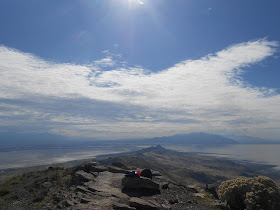A remote section of Antelope Island's ridgeline, looking east.
By Lynn Arave
MILES GOODYEAR WASN’T the only white settler who lived in Northern Utah when the Mormon Pioneers arrived in 1847. There was another, far lesser known man.
MILES GOODYEAR WASN’T the only white settler who lived in Northern Utah when the Mormon Pioneers arrived in 1847. There was another, far lesser known man.
Daddy Stump
was living on Antelope Island (originally called “Church Island”) when the
Mormon started exploring the Isle in 1848. That’s also the first mention of the
man.
Stump,
believed to be a mountain man and perhaps also known as a bear killer, had
built a small cabin and had a small orchard of peaches on Antelope Island in
1848.
You could easily call Stump the mystery man of Antelope Island.
The LDS
Improvement Era Magazine from 1907 mentions Stump twice in its volume 10
contents. First, he is called an old mountain man. Secondly, several Mormon
Pioneers reported that Stump’s rustic camp was located in a little canyon near
a spring of water on the south end of the Island. Stump is referred to as an
“old trapper.”
The somewhat
mysterious Stump was not mentioned by government explorer John C. Fremont and
crew during their expedition of the Island in 1843. Thus, Stump may have only
been in Utah a few years before the Pioneers.
Most history
books do not even mention Stump, though they often cite Miles Goodyear (who
lived in West Ogden).
Having
“Daddy” as a first name was perhaps a nickname, that stuck with this solitary
mountain man – and coincided with his advanced age.
Fielding Garr Ranch sign on Antelope Island.
A history of
Fielding Garr (first Mormon settler in Antelope Island in 1849) on WikiTree.com
quotes a visit to Daddy Stump’s camp by Brigham Young on Antelope Island:
“In 1856 Brigham Young
visited Antelope island. ‘The time was pleasantly spent in driving over the
Island and in visiting places of interest-bathing, boating and inspecting their
horses and sheep. Old Daddy Stump's mountain home was visited. They drove their
carriage as near to it as possible and walked the remainder of the way.
Everything was found just as the old man had left it. It was located at the
head of a small, open canyon against a steep mountain. The house was made of
cedar posts set upright and covered with a dirt roof. Close to it was a good
spring of water....’"
Some sources
indicate that Stump, a solitary man, may have left Antelope Island by 1849,
after the Fielding Garr Ranch was established there by the Mormon Pioneers.
It is also
generally accepted that he is believed to have disappeared six years later, in
1856 – with the assumption that he was killed by Indians that year in Cache
Valley.
The book, “History
of Utah,” by Orson F. Whitney, also very briefly mentions Stump as taking
cattle to Cache Valley and that most of his herd died there (presumably from a
harsh winter). Whitney mentions that others also lost most of their cattle
there too.
Today, Stump
is forgotten by most history books – except for perhaps a mention in a single
line.
His only
remaining legacy is that a ridge on the south end of Antelope Island is honored
with his name.
Daddy Stump Ridge rises
about 1,200 feet above the level of the Great Salt Lake. It is located along
the main ridge line, about half-way to the south between Frary Peak and the
southern tip of the Island.
-Also, Antelope Island
State Park periodically hosts a seasonal hike, called the “Daddy Stump History
Tour.” It visits the site where Stump homesteaded and offers an overview of the
Island’s history.
Note too that buffalo were not native to Antelope Island and were first added in the early 1890s.
Note too that buffalo were not native to Antelope Island and were first added in the early 1890s.
The Fielding Garr Ranch on Antelope Island.




No comments:
Post a Comment